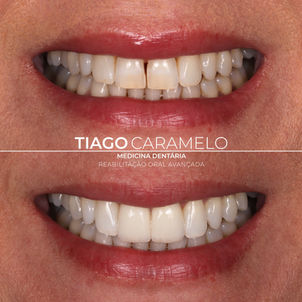CERAMIC CROWNS
Ceramic crowns are prosthetic restorations that encase the tooth in order to increase its strength, as well as improve its aesthetic appearance. Ceramic is the material that best mimics the tooth structure, making it an excellent solution to restore harmony to your smile.

INDICATIONS FOR CERAMIC CROWNS
Ceramic crowns are used in various clinical situations that affect the functionality and aesthetics of the tooth. They are recommended for:
-
Teeth with extensive restorations that compromise their structure;
-
Non-vital (devitalized) teeth, which tend to become more fragile and prone to fractures;
-
Fractured teeth or those with significant structural damage;
-
Cases where improving dental aesthetics is necessary, particularly in situations involving changes in tooth colour or shape;
-
Oral rehabilitation cases where missing teeth need to be replaced using dental implants.
BENEFITS OF CERAMIC CROWNS
The use of ceramic crowns provides several benefits both functionally and aesthetically:
-
Naturalness: Ceramic is the material that best mimics tooth enamel, offering a very similar appearance to natural teeth;
-
Durability: When properly cared for, ceramic crowns can last many years, resisting daily chewing and wear;
-
Comfort: Ceramic crowns are biocompatible, meaning they do not cause allergic reactions or gum irritation;
-
Strength: This type of restoration reinforces the tooth structure, preventing fractures;
-
Conservation of Tooth Structure: The use of crowns helps preserve as much healthy tooth structure as possible;
-
Precise Fit: Ceramic crowns are custom-made for each patient, ensuring a perfect and comfortable fit;
-
Easier Cleaning: The smooth surface of ceramic makes it difficult for plaque to accumulate, helping maintain oral hygiene.

TREATMENT EXECUTION:
When placing ceramic crowns, I follow a strict protocol that ensures the safety and predictability of the results.
1st Planning
In this first phase of treatment, I collect all the necessary information for the correct execution of the procedure. This includes intra-oral and extra-oral photographs, as well as radiological exams, such as the panoramic radiograph.
The patient will have the opportunity to see the final smile that I have designed, thus anticipating the final outcome of the entire treatment. Additionally, it is possible to create a digital impression of the oral cavity using an intraoral scanner.
This procedure replaces traditional plaster molds, offering greater comfort and precision to the patient, allowing the digital model to be sent directly to the laboratory to ensure a more accurate fabrication of the crowns.
2nd Tooth Preparation and Placement of Temporary Crowns
In this appointment, the dental structure is prepared, temporary crowns are placed, and the final impression for the ceramic crowns is taken. The temporary crowns are important for protecting the prepared teeth and maintaining both aesthetics and functionality until the final crowns are placed.
The shade of the ceramic is chosen during this phase, ensuring that the final color of the crowns will be as natural as possible and harmonious with the adjacent teeth.
3rd Placement of Ceramic Crowns
Around 5 to 7 days later, the ceramic crowns are tried on and placed, restoring both dental aesthetics and function. The cementation is performed with adhesive materials that ensure a secure and long-lasting bond.
During this process, the bite adjustment is carefully checked, ensuring that the crowns do not cause discomfort to the patient and allow for efficient chewing.

POST-TREATMENT CARE
To ensure the longevity of ceramic crowns, it is essential to adopt some daily care habits:
-
Maintain good oral hygiene by brushing your teeth at least twice a day and using dental floss;
-
Use non-abrasive toothpaste to avoid premature wear of the ceramic;
-
Attend regular dental check-ups to monitor oral health and the stability of the crowns;
-
Use a protective mouthguard if you practice contact sports to prevent trauma.
DIFFERENCES BETWEEN CERAMIC CROWNS AND OTHER TYPES OF CROWNS
There are different types of dental crowns, with the main ones being:
-
Metal-ceramic crowns: Composed of a metal structure covered with ceramic, which provides strength. However, they may compromise aesthetics due to the presence of metal;
-
Zirconia crowns: They offer great strength and excellent aesthetics, being the most commonly used alternative nowadays;
-
Resin crowns: Less durable and typically used temporarily.
Fully ceramic crowns stand out for their excellent aesthetic integration and biocompatibility, making them the ideal choice for the front region of the mouth.
Furthermore, there is no risk of gum recession that could darken the gum line, as can occur with metal-ceramic crowns.
TECHNOLOGIES APPLIED IN THE MANUFACTURE OF CERAMIC CROWNS
The evolution of digital dentistry has brought significant improvements in the manufacturing of ceramic crowns. Currently, I use advanced technologies such as:
-
CAD/CAM (Computer-Aided Design and Manufacturing): Allows for personalized digital design and precise milling of the crown, ensuring a perfect fit and greater durability;
-
3D Printing: Used for producing more detailed and accurate dental models;
-
Intraoral Digital Impressions: Replaces traditional molds, making the process more comfortable for the patient and increasing the accuracy of the crowns.
Conclusion
Ceramic crowns are an effective and aesthetic solution to restore compromised teeth, ensuring a harmonious and functional smile. I use high-quality materials and advanced technology to provide safe, durable treatment tailored to each patient's individual needs. If you need to restore one or more teeth, schedule a consultation with me to find out how ceramic crowns can improve your oral health and the aesthetics of your smile.
CLINICAL CASES






































